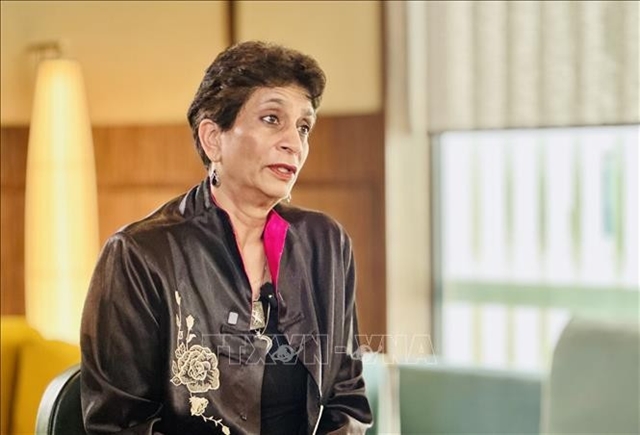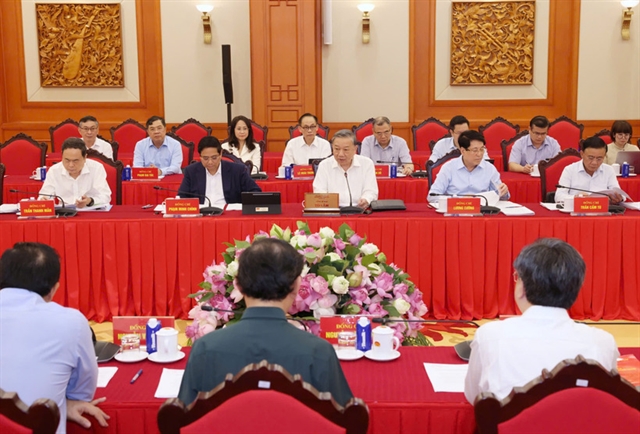

It is time for everyone to know about how difficult it has become for langurs to survive.
Especially for people in Da Nang where the animals live, in the Sơn Trà Nature Reserve.
52722435PM.JPG) |
| A photo of the red-shanked douc langur (Pygathryx nemaeus) was taken by wildlife photographer Nguyễn Trường Sinh in the Sơn Trà Nature Reserve in Đà Nẵng City. A communication campaign for the protection of the endangered langurs has been launched in the city. Photo courtesy GreenViet |
It is time for everyone to know about how difficult it has become for langurs to survive.
Especially for people in Da Nang where the animals live, in the Sơn Trà Nature Reserve.
Some people have been caught for hunting the precious creatures.
People also break the law in the nature reserve by sawing down forest trees to make logs.
ĐÀ NẴNG — The Biodiversity Conservation Centre, GreenViet, has launched a communication campaign to protect the red-shanked douc langur (Pygathryx nemaeus) in the Sơn Trà Nature Reserve in this city.
The centre’s vice director, Lê Thị Thu Trang, said photos of the primates taken by French wildlife photographers Cyril Russo and Vietnamese Nguyễn Trường Sinh have been posted on bus stops in Đà Nẵng main streets.
She said the move aimed to raise awareness among the community and the tourists on the need for protection of the red-shanked douc langur.
Trang said scientists and biologists from the International Union for Conservation of Nature (IUCN) had agreed to list the red-shanked douc langur as critically endangered (CR) with unlimited protection status in the world. In 2013, IUCN had listed the animal as endangered (EN).
The Sơn Trà Nature Reserve, which is 10km from Đà Nẵng’s centre, is known for its rich biodiversity, with 287 species of animals and 985 species of plants. The 2500ha reserve, which is 600m above sea level, is home to 300 red-shanked douc langurs – only found in east-central Laos and Việt Nam.
The reserve is a favourite tourism destination, with 10,000 tourists visiting the reserve every month.
Last year, the city’s forest protection sub-department prosecuted a criminal case that involved the illegal killing of three red-shanked doucs in the reserve.
According to GreenViet, traps are still found in the reserve and illegal hunting continues.
Many restaurants built inside the reserve have been used for illegal hunting and wildlife trafficking in the area.
Illegal loggers have also destroyed a vast area in this protected nature reserve on the Sơn Trà Peninsula.
Two illegal hunting cases were documented in the reserve last year, while 2,000 traps were dismantled by rangers and volunteers.
Earlier this year, a monkey (Indochinese rhesus macaque) was killed by a motorcyclist on the Sơn Trà Mountain.
The Đà Nẵng-based GreenViet is also co-operating with the Frankfurt Zoological Society of Germany, the San Diego Zoo Global in the United States and the IUCN to protect the red-shanked douc langur through long-term campaigns.
The city plans to make the red-shanked douc langur the city’s symbol of biodiversity at the Asia Pacific Economic Co-operation Summit (APEC) in Đà Nẵng in 2017. — VNS
GLOSSARY
The Biodiversity Conservation Centre, GreenViet, has launched a communication campaign to protect the red-shanked douc langur (Pygathryx nemaeus) in the Sơn Trà Nature Reserve in this city.
A communication campaign is a special effort to get to talk to people.
Every living thing, plant or animal, has a scientific name, in Latin, which tells exactly what it is and where it fits into the animal or plant kingdoms. Pygathryx nemaeus is the scientific name of the red-shanked douc langur.
The centre’s vice director, Lê Thị Thu Trang, said photos of the primates taken by French wildlife photographers Cyril Russo and Vietnamese Nguyễn Trường Sinh have been posted on bus stops in Đà Nẵng main streets.
The vice director is the next person in charge, after the director.
Primates are the group of animals that includes humans, monkeys, chimpanzees, gorillas, orang-utans and so on.
Trang said scientists and biologists from the International Union for Conservation of Nature (IUCN) had agreed to list the red-shanked douc langur as critically endangered (CR) with unlimited protection status in the world.
A biologist is a scientist that studies and knows a lot about living things.
If an animal, or plant is endangered there are not many of them left and they are in danger of dying out forever.
The Sơn Trà Nature Reserve, which is 10km from Đà Nẵng’s centre, is known for its rich biodiversity, with 287 species of animals and 985 species of plants.
A place with rich biodiversity has many different types of plants and animals.
A species of animal is a type of animal.
The reserve is a favourite tourism destination, with 10,000 tourists visiting the reserve every month.
A destination is a place you travel to.
Last year, the city’s forest protection sub-department prosecuted a criminal case that involved the illegal killing of three red-shanked doucs in the reserve.
To prosecute means to start legal proceedings against someone.
A criminal case is a case that involves someone accused of breaking a law. Other cases, such as a civil case may involve people who disagree with one another rather than someone who breaks a law.
According to GreenViet, traps are still found in the reserve and illegal hunting continues.
A trap is a device used to catch animals.
Illegal loggers have also destroyed a vast area in this protected nature reserve on the Sơn Trà Peninsula.
An illegal logger is someone who breaks the law by chopping down trees in a forest to use them as logs.
Two illegal hunting cases were documented in the reserve last year, while 2,000 traps were dismantled by rangers and volunteers.
To document a hunting case means to make a record of it.
To dismantle a trap means to pull it apart.
Volunteers are people who work willingly for no money.
The Đà Nẵng-based GreenViet is also co-operating with the Frankfurt Zoological Society of Germany, the San Diego Zoo Global in the United States and the IUCN to protect the red-shanked douc langur through long-term campaigns.
Co-operating means working together.
Long-term campaigns are schemes that are planned to take place over a long time.
WORKSHEET
State whether the following sentences are true, or false:
© Duncan Guy/Learn the News/ Viet Nam News 2016
1. False; 2. True; 3. False; 4. False; 5. False.




